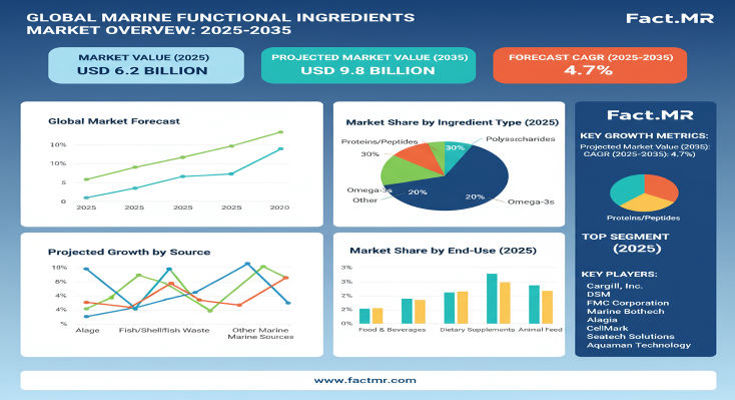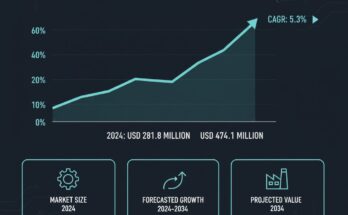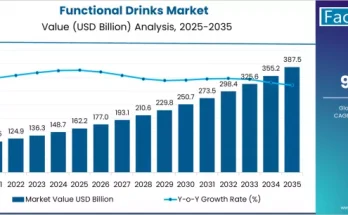A detailed analysis by skilled analysts at Fact.MR reveals that the global marine functional ingredients market is valued at US$ 4,080.7 million in 2023 and is projected to reach US$ 7,446.5 million by 2033, registering a CAGR of 6.2% during the forecast period. The growing shift toward sustainable, nutrient-rich, and bioactive compounds derived from marine sources is reshaping the future of food, pharmaceuticals, and cosmetics. As industries explore cleaner and more natural alternatives, marine-derived ingredients such as omega-3 fatty acids, collagen, chitosan, and algal extracts are finding widespread application across various sectors.
Rising Demand for Natural and Sustainable Ingredients
Consumers across the globe are becoming increasingly conscious of product origin, sustainability, and health impact. This trend has fueled the demand for marine-based functional ingredients due to their natural extraction processes and high nutritional value. Marine ingredients, such as proteins, polysaccharides, enzymes, and lipids, are now being extensively used in dietary supplements, personal care products, and pharmaceuticals for their anti-aging, antioxidant, and anti-inflammatory properties.
Click Here for Sample Report Before Buying: https://www.factmr.com/connectus/sample?flag=S&rep_id=8712
Moreover, sustainable fishing practices and innovative aquaculture solutions have made it possible to harness marine bioresources responsibly. By utilizing byproducts from seafood processing, companies are reducing waste while unlocking new revenue streams through ingredient extraction. This circular economy model not only benefits the environment but also enhances profitability and market competitiveness.
Technological Advancements Boosting Ingredient Extraction
The growth of the marine functional ingredients market is strongly supported by advancements in extraction and purification technologies. Techniques such as enzyme-assisted extraction, supercritical fluid extraction, and membrane filtration have significantly improved yield and purity levels of marine compounds. These innovations have enabled manufacturers to produce high-quality ingredients while maintaining bioactivity and sustainability.
Additionally, biotechnology and marine bioprospecting are expanding the range of available marine ingredients. Algae-based bioactives, for instance, are gaining popularity as sustainable alternatives to synthetic ingredients in food and cosmetics. Marine collagen, sourced from fish skin and scales, is increasingly replacing animal-derived gelatin in beauty and nutraceutical products. This technological evolution is setting the stage for large-scale commercialization and product innovation across multiple industries.
Applications Across Diverse End-Use Industries
The marine functional ingredients market spans several high-growth industries. In the food and beverage sector, marine proteins and omega-3 oils are being incorporated into functional foods, beverages, and dietary supplements to enhance nutritional profiles. These ingredients promote heart health, improve brain function, and boost immunity, making them ideal for health-conscious consumers.
In the cosmetics and personal care industry, marine bioactives such as collagen, peptides, and seaweed extracts are widely used in anti-aging creams, serums, and skin-nourishing products. The natural origin and efficacy of these ingredients appeal to consumers seeking clean-label and eco-friendly formulations. Meanwhile, in pharmaceuticals, marine-derived polysaccharides and lipids are used in drug delivery systems and tissue engineering due to their biocompatibility and therapeutic benefits.
The animal feed sector also represents a promising avenue for growth, with marine ingredients used as high-protein supplements that enhance animal growth, health, and immune response. This broad application spectrum demonstrates the versatility and expanding relevance of marine functional ingredients in the global bioeconomy.
Regional Insights
North America and Europe remain dominant markets due to high consumer awareness of health supplements and the presence of established marine biotechnology companies. The Asia Pacific region, however, is projected to experience the fastest growth during the forecast period. Countries such as Japan, South Korea, and China are heavily investing in marine biotechnology research, leveraging their rich coastal biodiversity. The increasing use of marine ingredients in traditional Asian skincare and dietary products is also accelerating demand in the region.
Latin America and the Middle East are emerging as new opportunities, particularly as seafood processing industries expand and governments promote sustainable marine resource utilization. Growing investments in local aquaculture and bioprocessing infrastructure are expected to support long-term market expansion in these regions.
Competitive Landscape and Strategic Developments
The marine functional ingredients market is moderately fragmented, featuring a mix of multinational corporations and regional producers. Key players are focusing on mergers, acquisitions, and joint ventures to strengthen their product portfolios and enhance market reach. They are also investing in sustainable sourcing partnerships to ensure traceability and transparency throughout the supply chain.
Recent developments indicate a strong focus on innovation. Companies are introducing advanced formulations that combine marine bioactives with other natural ingredients to target specific health and cosmetic benefits. For example, marine collagen blended with botanical extracts or vitamins is being marketed as a premium anti-aging solution. Strategic collaborations between ingredient manufacturers, research institutions, and end-use companies are also driving the creation of customized and application-specific solutions.
Future Outlook
The marine functional ingredients market is poised for rapid expansion as global industries pivot toward sustainability and natural health solutions. The integration of marine-derived compounds into everyday products signifies a major shift in consumer preferences and manufacturing strategies. As ocean-based resources become central to global bio-innovation, the next decade is expected to witness a surge in research, product launches, and strategic partnerships.
Fact.MR’s latest market report provides a comprehensive assessment of current trends, growth drivers, challenges, and competitive dynamics shaping this evolving landscape. The report offers detailed segmentation by ingredient type, source, application, and region, helping businesses identify key investment areas and strategic opportunities.
Browse Full Report: https://www.factmr.com/report/marine-functional-ingredients-market
Why Purchase This Report?
This report delivers the intelligence that business leaders need to make informed decisions. It not only quantifies the market’s growth potential but also provides actionable insights into emerging technologies, evolving consumer trends, and competitive benchmarking. Buyers will gain access to data-backed projections, industry-leading forecasts, and practical recommendations to navigate this fast-growing segment effectively.
The Marine Functional Ingredients Market Report is more than a market overview — it is a strategic roadmap for investors, product developers, and industry executives aiming to capitalize on the next wave of blue bioeconomy innovation. With sustainable growth opportunities spanning nutrition, wellness, and cosmetic applications, now is the time for businesses to dive deep into this promising market and harness the untapped potential of the world’s oceans.



